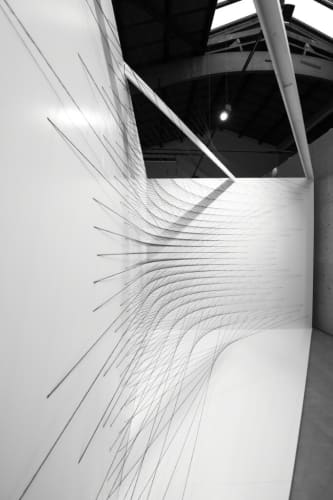"Only when we move and choose another angle can we truly find perspective."
Being both an artist and an architect, the main theme in the work of Robbert de Goede (1969, NL) is the study of human behaviour in inner environments. Central themes are time, speed, movement, light as well as meditation. De Goede is interested in the way we approach, move through and behave in spaces. He creates enclosed spaces, as a starting point for each composition, and looks for the spaces within.
De Goede's works form a solid, ordered reality. Searching for compositions he finds inspiration in (micro)cosmological events and mathematical issues, and in interactions that are taking place in those 3D environments, free from our limited perspective on gravity and everyday physics. Explosions, collusions, floating forms, relations between independent objects. De Goede considers his audience ‘experiencers’; for it is not by merely viewing that his work is comprehended. "I incorporate the human body in the experience as a tool to give the intellect a smaller role. This stimulates learning by experience. One will try to find out what is going on in the works. By moving around the story develops. Participation brings far more insight than being a static viewer. I find this analogous to how we interact with our surroundings and with other people."
Through the use of abstract materials, almost singular in character, it is very hard to find a good physical focus in the compositions. "One might get quite dizzy experiencing the work. In this physical experience, time seems to stand still. This could provoke a moment of meditation, which in itself is one of the aims of my work." Creating new work is a process of turning chaos into order. De Goede starts by sketching random shapes on paper, continuously drawing until he finds interesting combinations. Mathematically describable shapes and rhythms function as a rational test for his compositions. "It is easier to relate to these shapes because they are founded in universal truth. Creating a successful composition is reliant on balancing reason, math, complexity and gut feeling." The final process entails fine-tuning and looking for hidden forms, where shapes either clash or complement each other. Using wires is a direct result of his practice as an architect. The wire-frame models from 3D software turn out to be a great medium for making minimalistic work. More wires give more colour, less wires give more space and light. Each artwork requires drilling 2 to 4 thousand holes and connecting these with kilometres of thread or wire. The trick is to think and perform methodically, hole after hole, thread after thread. The process is meditative. It is a continuous repetition of the same steps demanding a concentrated flow.
As both an artist and an architect De Goede finds his art in the tension between the two professions. "The in-between space has always fascinated me. My freedom to move between these occupations inspires me to investigate transformations. Only when we move and choose another angle can we truly find perspective."
